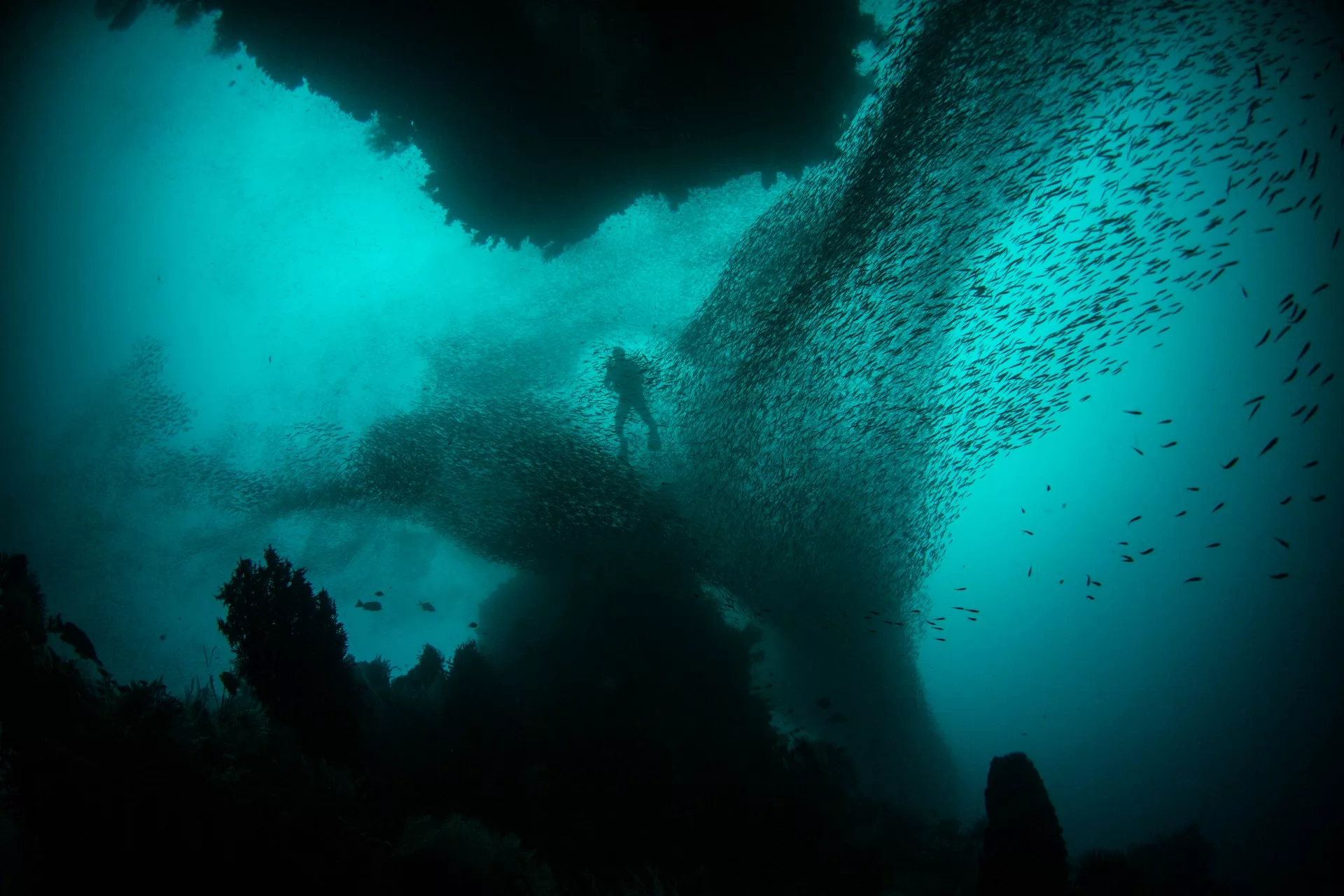Underwater, a symphony of natural and artificial noise shapes marine ecosystems. Photo credit: Alex Rose via Unsplash
The global soundscape encompasses the “soniferous” world, the “phonocene”, and, in the aquatic realm, the “ocean soundscape”—where the field of marine bioacoustics combines biology and sound. Recognising the role humans play in the sounds made beneath the waves, scientists have adapted the study to that of the ‘soundscape of the Anthropocene ocean’. Such a variety of terminology indicates the emerging traction of research into noise pollution. Unfortunately, however, this has yet to translate earnestly into policy.
Soundscapes are defined as ‘ambient sound in terms of its spatial, temporal, and frequency attributes, and the types of sources contributing to the sound field’. Living and non-living sources of sound can be further categorised into ‘biophony’ (sounds of biological origin, such as whale song), ‘geophony’ (natural sounds stemming from weather and seasonal variations, such as waves breaking), and ‘anthrophony’ (sounds generated by human activities, such as underwater sensing techniques like seismic surveys).
Although light always travels faster than sound (with lightning always preceding thunder), sound can travel five times faster and further underwater than in the air. Naturally then, sound is a key sensory faculty for marine wildlife, who can manipulate its rate, pitch, and structure to quickly convey and receive information over long distances. These interactions may be with both groupmates or other species.
…sound is a key sensory faculty for marine wildlife…
Species-specific biophonic sound bands provide essential signals which maintain group structure and territory, attract mates, and echolocate (where sound waves produced by an individual can be interpreted to provide a 3D view of the environment). Such interconnected dynamics reveal themselves in underwater reefs. Reefs emit geophonic sounds which reef fish larvae can detect and use to direct them towards potential coastal habitats to settle. Evidently, the active soundscapes hosted by the ocean are vital to the continued survival of marine species.
Yet, studies show that anthrophony is a stressor for marine organisms. There are many anthropogenic sound sources, including the operational noise of turbines and marine traffic noise such as from shipping boats. These impact marine ecosystems from the species to the community level in two ways. Biophonic and geophonic noise has declined or changed because of human activity. Further still, the variety, intensity, and frequency of anthropogenic sound may have overtaken levels produced by natural acoustic stimuli. This leads to auditory masking—the distortion of sound perception due to the presence of another sound.
These [human noise] impact marine ecosystems from the species to the community level in two ways.
Moreover, oceanic warming causes sound to travel faster through the water. Combined with ocean acidification and deoxygenation, this results in a noisier ocean. The human reach, both directly and indirectly, has significant implications on marine species’ physiology and behaviour, such as inducing startle responses in certain fish species.
Scientists have recognised this threat for decades. Yet, policies addressing anthropogenic noise in the ocean soundscape are still lacking. The 2008 European Commission’s Marine Strategy Framework Directive was the first international legislation to explicitly address underwater noise pollution. It has limited both continuous (e.g., from shipping) and impulsive (e.g., from gas exploration) noise, thereby regulating human-generated noise as a point-source noise pollutant (with impacts declining once the sources are removed). The legislation also ensures that no more than 20% of any marine area in EU waters can be exposed to the constant rumbling sounds produced by marine traffic. This has had, and will continue to have, immediate and compounded impacts on the soundscape.
The COVID-19 pandemic illuminated the extent humanity impacts marine bioacoustics, but also illustrated our agency, offering hope for an alternative future for the “wavescape”. Global lockdowns engendered the ‘unusual expansion in the movements of marine mammals and sharks’, coinciding with the longest quiet period of anthropogenic seismic noise on record.
The COVID-19 pandemic illuminated the extent humanity impacts marine bioacoustics…
Looking forward, ocean sound is an increasingly important (and non-invasive) arena for scientific study, for example in the application of acoustic barriers in European wind farms. Its relevance is set to continue as the United Nations’ Maritime Acoustic Environment Programme calls for improved global capacity for ocean soundscape research.
Translating research into policy mandates global cooperation. The 2023 UN High Seas Treaty represents a ‘historic’ breakthrough that foregrounds ‘multilateralism’ and recognises the central role of geopolitics. Managing the marine soundscape’s ‘biodiversity beyond national jurisdiction’ invites a way to return our oceans to their natural wavescapes.





